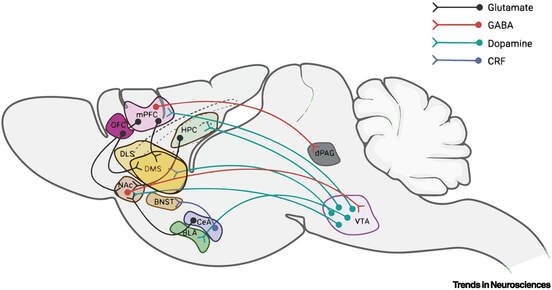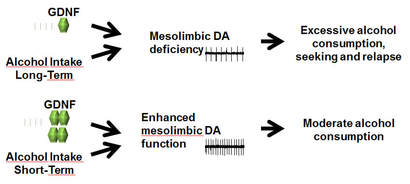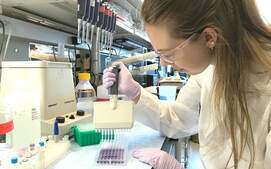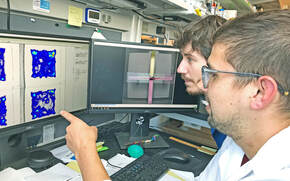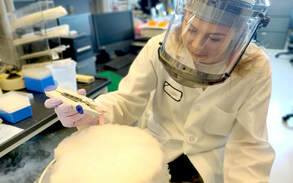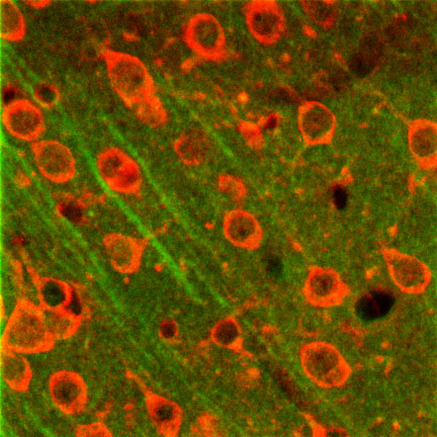Dorit Ron's Research
Harmful, excessive use of alcohol has a severe impact on society and is one of the major causes of morbidity and mortality in the population. Unlike other drugs of abuse, alcohol does not have a well-defined site of action. Thus, mechanisms that underlie alcohol’s actions in the brain are poorly understood, and available medications for alcohol use disorders are limited. My lab is interested in elucidating molecular neuroadaptations that occur in the adult brain in response to alcohol exposure. Our long-term goal is to identify novel targets that could be developed as therapeutics to treat alcohol abuse disorders including excessive alcohol intake, seeking and relapse. To do so, we combine molecular, genetic, and behavioral paradigms in rodents to address the following questions:
- Which neural pathways drive the transition from social drinking to excessive, uncontrolled alcohol intake, regardless of negative consequences, and how can this transition be prevented?
- What are the mechanisms that prevent the majority of social drinkers from developing alcohol abuse disorders?
Reviews
Gabor Egervari, Cody A. Siciliano, Ellanor L. Whiteley, Dorit Ron. Alcohol and the brain: from genes to circuits. Trends Neurosci. 2021 Oct 23;S0166-2236(21)00187-9. doi: 10.1016/j.tins.2021.09.006.
Ron D. and Barak S. Molecular mechanisms underlying alcohol-drinking behaviors. Nature Reviews Neuroscience. 17, 576–591, 2016.
Ron D, Berger A.Targeting the intracellular signaling "STOP" and "GO" pathways for the treatment of alcohol use disorders. Psychopharmacology. 235(6):1727–1743, 2018.
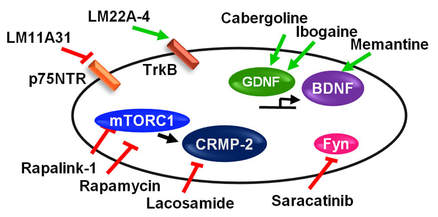
Barak S, Ahmadiantehrani S, Logrip ML, Ron D. GDNF and alcohol use disorder. Addict Biol. May;24(3):335-343, 2019.
Ron D, Weiner J. Special issue on new technologies for alcohol research and treatment. Alcohol. Feb;74:1-2, 2019.
Laguesse S and Ron D. Protein Translation and Psychiatric disorders. The Neuroscientist. Feb;26(1):21-42, 2020.
Egervari G, Siciliano C.A., Whiteley E.L., Ron D. Alcohol and the brain: from genes to circuits. Trends in Neuroscience Oct 23;S0166-2236(21)00187-9, 2021.
Morisot N, Ron D. Alcohol-Dependent Molecular Adaptations of the NMDA Receptor System. Genes Brain Behav. 2017 Jan;16(1):139-148. doi: 10.1111/gbb.12363.
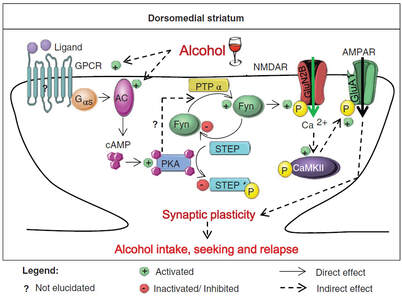
Beckley JT and Ron D. Molecules to Medicine with mTOR. Elsevier Academic Press. 2016. 215-226.
Logrip ML, Barak S, Warnault V, Ron D. Corticostriatal BDNF and alcohol addiction. Brain Res. 2015 Dec 2;1628(Pt A):60-7.
Neasta J, Barak S, Ben Hamida S, Ron D. mTOR Complex 1: A Key Player in Neuroadaptations Induced by Drugs of Abuse. J Neurochem. 2014 Jul;130(2):172-84.
Warnault V, Ron D. Chromatin remodeling: a new landscape to treat harmful alcohol-use disorders. Future Med Chem. 2013; 5:2011-3.
Ron D, Adams DR, Baillie GS, Long A, O'Connor R, Kiely PA. RACK(1) to the future - a historical perspective. Cell Commun Signal. 2013; 11:53.
Ron D. and Messing RO. Signaling pathways mediating alcohol effects. Curr Top Behav Neurosci. 2013; 13:87-126.
Adams DR, Ron D, Kiely PA. RACK1, A Multifaceted Scaffolding Protein: Structure and Function. Cell Commun Signal. 2011; 9:22.
Carnicella S and Ron D. GDNF--a potential target to treat addiction. Pharmacol Ther. 2009; 22:9-18.
Ron, D. and Janak, P.H. GDNF and Addiction. Reviews in the Neurosciences. 2005; 16:277-285.
Ron, D. and Jurd, R. The "ups and downs" of signaling cascades in addiction. Science STKE. 2005; 309:14,5.
Ron, D., Signaling Cascades Regulating NMDA Receptor Sensitivity to Ethanol. Neuroscientist. 2004; 10:325-336.
Adams DR, Ron D, Kiely PA. RACK1, A Multifaceted Scaffolding Protein: Structure and Function. Cell Commun Signal. 2011; 9:22.
Carnicella S and Ron D. GDNF--a potential target to treat addiction. Pharmacol Ther. 2009; 22:9-18.
Ron, D. and Janak, P.H. GDNF and Addiction. Reviews in the Neurosciences. 2005; 16:277-285.
Ron, D. and Jurd, R. The "ups and downs" of signaling cascades in addiction. Science STKE. 2005; 309:14,5.
Ron, D., Signaling Cascades Regulating NMDA Receptor Sensitivity to Ethanol. Neuroscientist. 2004; 10:325-336.
Current Projects
- Identification of the mechanisms and circuitries underlying the unique role of brain-derived neurotrophic factor (BDNF) in alcohol-dependent behaviors.
- Determining the mechanisms and circuitries underlying mTORC1’s activity in heavy alcohol use and habit.
- Elucidating the role of kinases, including Fyn kinase and PKA, in normal CNS functions and in neuroadaptations underlying addiction.
- Identifying the role of small G proteins in neuroadaptations underlying alcohol use disorder.
Tools
The Ron lab utilizes a wide range of molecular, biochemical, and behavioral techniques to uncover the molecular mechanisms that underlie alcohol use and abuse disorders.
Molecular Biology and BiochemistryWe use both classical (Western- blot, ELISA, RT-PCR, qPCR, immunoprecipitation (IP), co-IP, immunohistochemistry) and state-of-the-art and newly developed molecular tools (RNA-seq, microRNA-qPCR, etc.) to assess the levels of mRNA and microRNA, detect epigenetic changes, and examine protein levels, localization and interactions in specific brain regions or in specific subpopulations of neurons. We also utilize virus-mediated gene delivery to knockdown or overexpress genes in brain regions and neurons of interest. We employ fractionation techniques to isolate cellular compartments, such as nuclei, lipid rafts and synapses. We further use polysomal fractionation, a procedure that allows us to specifically study transcripts bound to ribosomes (i.e. mRNA undergoing transcription). We use Scholl analysis to study neuron morphology. |
BehaviorWe use rodents (mice and rats), including numerous transgenic mouse lines, to study the involvement of specific pathways and circuitries in alcohol use disorders. We modify gene expression in isolated brain regions and within specific neural circuits using viral-mediated gene delivery. We also use transgenic reporter mouse lines in combination with Cre-dependent DREADDs to exogenously excite or inhibit neuronal subpopulations or specific circuits. To assess the behavioral effects of these genetic manipulations, we use a variety of paradigms of voluntary alcohol drinking. We use the two-bottle choice with continuous access to alcohol paradigm to mimic moderate alcohol intake and the two-bottle choice with intermittent alcohol access paradigm to model excessive or binge-like drinking behaviors. Mice and rats may also undergo alcohol self-administration experiments, which allow us to study motivation for alcohol, as well as extinction and relapse responses. To assess the hedonic or aversive properties of alcohol and other drugs, we use conditioned place preference or aversion procedures. We also incorporate other methods to assess alcohol-related behaviors, such as alcohol-induced behavioral sensitization, anxiety-like behaviors (open field, elevated-plus maze, light\dark box), ataxia (rotarod), sedation (loss of righting reflex) compulsivity (Y maze) and sociability (three-chamber and open field social interaction). |


